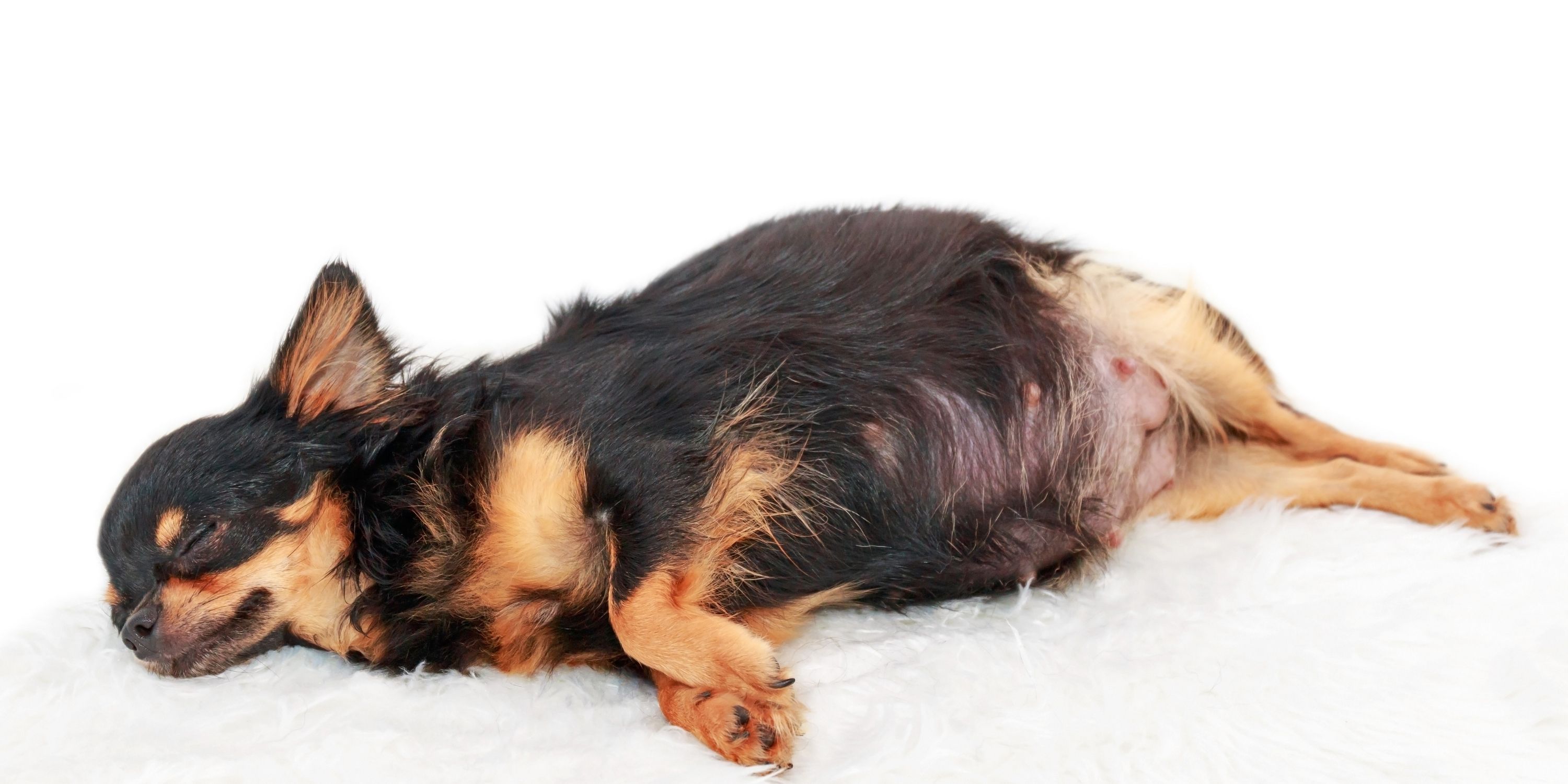Recognizing the signs of labor helps to ensure smooth and safe delivery for your bitch. It also ensures that you’re fully prepared for what’s to come so that you can better support your bitch and her puppies.
Laboring dog signs include panting, straining, vomiting, a loss of appetite, and licking of the genitals. Read on with us to find out more about the signs your dog is in labor!
Dog Gestation Period
To explain how long the dog gestation period is, we must first cover the dog reproductive cycle. An intact female dog goes into heat about every six months, though this may vary from breed to breed. The heat cycle goes on for 18 to 21 days and consists of four different stages. These are the proestrus, estrus, diestrus, and anestrus stage. During your dog’s heat cycle, she can become pregnant, and the gestation period then begins.
A female dog’s gestation period lasts for about 63 days or 8 to 9 weeks. Keeping track of the days is very important in estimating her delivery date!

Week 1: Breeding and Fertilization
In the first week, fertilization occurs. At this stage, you don’t need to make any changes to your bitch’s diet or exercise regime. There will be very few if any signs of pregnancy at this stage of gestation. So, continue to feed your dog her high-quality diet and exercise her regularly!
Week 2: Implantation
In the second week, the fertilized egg descends into the uterus, where it becomes developing into puppies. Like the first week, your bitch requires no additional nutrients.
Week 3: Embryo development
By the third week, signs of pregnancy will begin to show. The fetuses will attach to the wall of the uterus, where they begin to receive all the vital nutrients they need to grow into healthy puppies. Because of this, your bitch’s appetite will increase slightly. You may notice changes in her mood, too, as well as morning sickness due to hormonal swings. Her morning sickness may increase or decrease her appetite.
Week 4: Fetuses begin forming and can be seen on ultrasound
The fourth week is one of the most important and delicate weeks of them all. At this stage, the puppies are very susceptible to developmental issues and defects. So, at this stage, it’s best to only give your bitch gentle exercise. This means no rough play or strenuous activities. When you take your bitch for her ultrasound, ask your vet about her changing nutritional requirements.
Week 5: Fetuses begin development of genitals
By the fifth week, the puppies are no longer just embryos – they’re fetuses! During this fetal phase, the organs all begin to form, and the puppies’ weights increase by 75%. With all of this development happening, your bitch will need a diet made for growth or reproduction. It’s best to feed her smaller portions and to gradually transition any changes in her diet over the course of a week to avoid causing tummy upsets. Also, at this stage, a vet may be able to tell you the sex of the puppies through an ultrasound.
Week 6: Pups start developing pigmentation and eyes
At six weeks of gestation, your bitch’s pregnancy will be very obvious. Her abdomen will be noticeably larger, her nipples become darker, and her breast tissue grows considerably. The puppies develop their skin pigmentation at this stage, too. Here, make sure to increase your bitch’s food intake and ensure that she’s fully on a diet for growth or reproduction. It’s also useful to prepare her whelping box now and to encourage your bitch to sleep there.
Week 7: Pups attain larger sizes
In the seventh week, the development pace speeds up considerably. The puppies develop claws, their skeletons solidify, and they gain weight rapidly. As a result, your bitch’s nutritional needs will change and she will need more energy and protein. You may find that her appetite decreases, though, as her distended abdomen may make it difficult for her to eat full meals. She may also shed hair on her belly and start producing her first milk.
Week 8: Pups develop fur and get into position for birth
With just one week to go, your bitch will begin preparing for the birth. She may seem restless and dig in her whelping area. It’s very important to limit strenuous activity at this time as it could lead to premature labor if it occurs. Your dog will also now be producing milk. And, because the fetuses now have fully ossified skeletons, your vet may give your bitch an X-ray to confirm the number of fetuses. However, not all vets find this step necessary.
Week 9: Birth is imminent
Finally, week nine brings us to the birth. Make sure that you and your bitch are ready! Your bitch should be familiar with her whelping box and should be nesting by now. She may become quieter and closed off as she prepares for birth. You will need clean linen or towels, disposable gloves, kitchen paper, scales to weigh the puppies, and the phone number of your vet.

Signs That Whelping is Imminent
There are seven key signs a dog is in labor:
Temperature Dropping
Your bitch’s body temperature can help to alert you about the impending birth. Around 24 hours before labor begins, there is a temporary drop in body temperature. Her normal temperature should be between 101 and 102.5F. But before labor, her temperature may drop to 98 to 99F. So, be sure to take your bitch’s temperature regularly in the final week of gestation.
Nesting
Before giving birth, a bitch will dig around in her whelping box. She will also appear restless and may wander around as if searching for a safe place or making sure that things are in order. Make sure that your bitch is familiar with her whelping box and encourage her to sleep in it when she’s tired. She may also be anxious during this time, so be sure to comfort and support her wherever you can.
Loss of Appetite
During her pregnancy, your bitch’s appetite may increase or decrease. She may seem ravenous one day but uninterested the next – this is normal. However, right before giving birth, many bitches will go off their food considerably. They may vomit due to hormonal swings, stress, and nausea.
Vomiting
Many bitches will vomit or appear nauseous as labor grows closer. This is normal. However, contact your vet if you have any concerns about her vomiting, or if anything seems off with her vomit, such as blood appearing in it.
Panting/Rapid breathing
With the stress of impending labor and their restless behavior, many bitches will begin panting harder and more often. Be sure to provide comfort and support to your bitch during this time, as impending labor is a difficult time for her.
Shivering/Contractions
As her temperature drops and her anxiety increases, your bitch may start shivering as labor grows closer. Her abdomen may also contract at times as she prepares for delivery. When labor finally begins, her contractions will grow much stronger. Your bitch’s contractions may make it appear as though she’s trying to have a bowel movement. The first puppy should come within 1 to 2 hours of the onset of contractions. If a puppy is not delivered within 2 hours, contact an emergency vet right away.
Licking Her Genitals
Your bitch might excessively lick her back end as labor approaches. This is a natural behavior that keeps her sanitary area clean of discharge, as well as soothes any pain in the area.

Dog Labour Signs: FAQ
Most dogs safely give birth at home. However, it’s important to have a vet who you can call if things become complicated. At home, you’ll need to set aside a specific place for your bitch to give birth. You’ll need to make sure that this space is set up correctly to reduce your bitch’s stress and to keep her comfortable.
For example, the whelping box must be easy to clean and an appropriate size for your bitch and her litter. You’ll need to cover the base with materials that keep in the heat, such as towels, sheets, or newspapers. The birthing area must also be hygienic, which means limiting how many people go into the area as well as frequent cleaning. It should also be a well-aired place that’s not too stuffy or draughty.
Be sure to call your vet if you have any concerns about your dog’s labor. You should also call your vet if your dog’s contractions go on for more than 2 hours without delivering any puppies. Be sure to look out for the 7 signs a dog is in labor to spot when labor is coming!
Your dog can have an ultrasound by the 25th day of pregnancy, a blood test by the 35th day, and an X-ray by the 45th day. Talk to your vet about your options, as not all vets feel that X-rays are necessary.
During the third trimester of pregnancy, your bitch will need a highly digestible, high-quality puppy/growth/development food. This may be given in the form of several small meals per day to maintain adequate calorie and nutrient intake. Your bitch does not need a different food in the first two trimesters of her pregnancy, but it is important that she does not lose weight or body condition during this time.
The dam’s energy requirements increase during lactation. She may require 2 to 4 times the calories of a normal adult dog. Once the puppies are born, the bitch can increase her food intake. But, the energy density of her food must be high enough or she will not be able to sustain milk production. Periodically assess her body condition to fine-tune her feedings, in which she should receive a highly digestible, high-quality puppy food.
There are seven signs a dog is in labor. These are a drop in temperature, nesting, loss of appetite, vomiting, panting, contractions, and licking her genitals.
